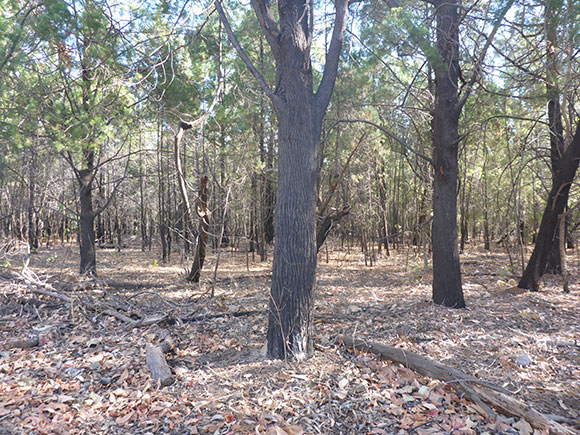Australian Blue Cypress Oil March 20, 2017
It’s as easy as ABC!
Australian Blue Cypress
INTRODUCTION
Most essential oils have a history – generations of traditional uses, cult stories and modern day successes but here’s an oil which certainly has a past story and with perhaps a few more chapters to write.
Callitris intratropica Cypress comes from the Greek word “sempervivens” which roughly translated means ‘live forever’. Native to Australia, it mainly grows in the Northern Territory and the Kimberly region of Western Australia and can grow between 15 and 45 metres in height at an altitude from sea level to around 900 metres.
It has a number Aboriginal names:
Karnitirrikani in Tiwi
Gangi/Lanapu in Djambarrpu
Munlark in Rembarrnga
Katanj in Jawony
Or also commonly known as Northern Australian Cypress Pine.
Callitris intratropica can live for over 200 years, although the population of Callitris intratropica has declined significantly since European settlement, because of over exploitation and the change in fire regimes and the introduction of grasses that burn with a greater intensity than the native grasses^. Thankfully today’s essential oil comes from well managed and sustainable plantations.
ESSENTIAL OIL

The oil has a distinct colour – cobalt blue to green
The essential oil which is extracted by steam or water distillation of the bark, sapwood and heartwood is the only naturally occurring blue oil that comes from a tree. Other blue essential oils are from floral plants like Blue Tansy and German Chamomile.
If you distil just the heartwood you would find that the colour is water white (clear) which contains clear azulene compounds. The blue coloured guaiazulene is formed when the essential oil of the heart and sapwood touches the bark and a catalytic reaction occurs. The oil can be bluish green to dark blue depending on the percentage of bark to heart wood ratio^.
Both the method of production and oil itself are patented (Australian Patent Number 742711). When the oil is first produced it has a very high guaiol content (26% – 30%). The oil at this high guaiol percentage becomes a solid at temperatures below 18° Celsius. The crystallised guaiol is separated from the liquid by vacuum filtration to achieve levels as low as 11%.
The bark and cambium contain around 85% alpha pinene. To achieve lower levels of alpha pinene the first hours of the distillation parts are drawn off. Or alternatively the logs and or woodchip are left and the volatile alpha pinene is expended to the atmosphere^.
AROMATHERAPY
Guaiazulene is claimed as an anti-inflammatory, anti-bacterial, anti-pyretic and anti-allergenic similar to chamazulene. Australian blue cypress oil also contains eudesmols known for their anti-viral properties hence its reputation amongst aromatherapists for the topical treatment of warts and cold sores.^
Its main constituents include b-Eudesmol, Dihydrocolumellarin, Guaiol, Gamma-Eudesmol and a-Eudesmol.
It is often described as an oil effective for soothing, warming and calming, generally good for mental clarity and focus, and reducing irritations.
Topically applied it can release the symptoms of tired joints and muscle pain as well as provide anti-inflammatory, analgesic and antiseptic properties to cuts, burns and insect bites (if you haven’t previously used it to prevent the bites!).
PERFUMERY
In recent years more analysis combined with greater economies of scale have allowed the doors to be opened to newer applications, in particular perfumery as a unique woody note.
Often classified as spicy, warm, balancing, smoky and honey like when describing it’s olfactory qualities it is also very substantive and acts as a perfect base note with good fixative properties, not too dissimilar to the functionality of sandalwood. It also blends well with other woody notes like vetiver, citrus and green tones.
COSMETICS

Callitris intratropica plantation in Northern Australi
Blue Cypress essential oil when applied to topical creams and lotions can provide a number of benefits, in particular for moisturising and hydrating dry skin. One very good application for this oil is in aftershave balms and creams.
It is also known to be an effective treatment of atopic dermatitis, the most common type of eczema. Using it together with your medication can help control flare ups and ease itchiness and inflammation.
For thousands of years the Aboriginal Tiwi people have burned Callitris intratropica wood to repel mosquitoes but applied topically in the correct proportion it can act as a skin repellent and (should it not work!) as a cure to reduce swelling and itchiness for bites and other skin irritations.
HISTORY
Generally the history is all about the wood since before its more recent introduction to the aromatherapy and perfumery markets it was better known as a quality hardwood. Historically there have been a number of investments made by local and federal authorities which over time have fallen into the abyss as the cost to maintain versus their purposefulness haven’t warranted further funding.
Over the last 150 years the tree wood has been used for the construction of telegraph poles (1870s), railway bridges (1880s) and more, with trial plantations first introduced in the 1950s, then on a more commercial scale in the 1970s. However planting soon stopped as costs escalated and the plantations were handed back from the Australian Government to the newly established and self-governed Northern Territory in 1978. Through the next 20 years the management of the plantations fell into various authorities hands before licenses were eventually issued for the harvesting of plantation trees for essential oil extraction in the 1990s.
Since then it has had a modern day history with many legal issues over patent laws, harvesting and commercial rights which can be read on ABC’s (Australian Broadcasting Company) archives – you may be surprised how many stories this little oil has had in recent years.
http://www.theage.com.au/articles/2004/04/20/1082395850945.html
Thankfully today those issues are all resolved and we can start to enjoy what we hope is a long period of sustainable supply of this truly magnificent oil. Investments in modern distillation equipment have been in place since 2016 and continue to be expanded with many new brands and perfumery companies investing in this essential oil.
^Thanks to Kakadu Blue australianbluecypress.com.au for their research and references
 Ultra International B.V.
Ultra International B.V.
